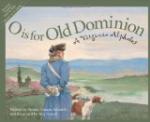Perhaps the river observed that we were getting a little out of patience; for, almost immediately, it sought to beguile us by bringing into view one of its show points, a landing on the left bank with a large brick house near by. The chart told us that this was Varina; and the guide-books told us a pretty story about how here, in their honeymoon days, lived John Rolfe and Pocahontas.
Although that honeymoon was almost three centuries gone, and there was nothing left at Varina to tell of it, yet somehow our thoughts quickened and Gadabout’s engines slowed as we sailed along the romantic site.
To be sure, to keep up the spirit of romance one has to overlook a good deal. The fact that John Rolfe had been married before and the report that Pocahontas had been too, somewhat discouraged sentiment. And then, was it love, after all, that built the rude little home of that strange pair somewhere up there on the shore? Or, had Cupid no more to do with that first international marriage in our history than he has had to do with many a later one? Can it be that politics and religion drew John Rolfe to the altar? and that a broken heart led Pocahontas there?
Poor little bride in any event! A forest child—wrapped in her doe-skin robe, the down of the wild pigeon at her throat, her feet in moccasins, and her hair crested with an eagle’s feather; bravely struggling with civilization, with a new home, a new language, new customs, and a new religion.
How many times, when it all bore heavy on her wildwood soul, did she steal down to this ragged shore, push out in her slender canoe, and find comfort in the fellowship of this turbulent, untamable river! And how often did she turn from her home to the wilderness, slipping in noiseless moccasins back into the narrow, mysterious trails of the red man, where bended twig and braided rush and scar of bark held messages for her!
Then came the time when the river and the forest were lost to her. The princess of the wilderness had become the wonder of a day at the Court of King James. Almost mockingly comes up the old portrait of her, painted in London when she had “become very formall and civill after our English manner.” The rigid figure caparisoned in the white woman’s furbelows; the stiff, heavy hat upon the black hair; the set face, and the sad dark eyes—a dusky woodland creature choked in the ruff of Queen Bess.
When Varina was left behind, we fell to berating the tortuous river again. Of course we did not think for a moment that the troublesome curlicues we were finding had always been there. When the river was the old, savage Powhatan, we may be sure it never stooped in its dignity of flow to such frivolity. These kinks were silly artificialities that came when the noble old barbarian was civilized and named in honour of a vain and frivolous foreign king.
Now, just ahead of us, was the most foolish frizzle of all. It was a loop five miles around, and yet with the ends so close together that a boy could throw a stone across the strip of land between. At a very early day, sensible folk lost patience and sought, by digging a canal across the narrow neck, to cut this offensive curl off altogether.




